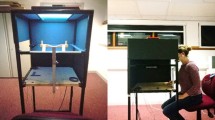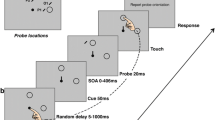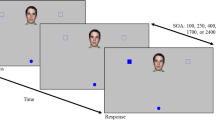Abstract
Three experiments were conducted with right-handed participants to examine between-trial inhibition and facilitation effects in goal-directed aiming. Participants were required to execute rapid left-hand or right-hand aiming movements upon illumination of a target light in left or right space. Thus, from trial to trial, participants executed movements to either the same target location or a different target location with the either same hand or the other hand. Our reaction time results indicated that participants were particularly slow in initiating their movements when they were required to return to the same target location with the other hand. This was especially the case when the right hand was required to move to a target just occupied by the left hand. For both reaction time and movement time the right hand but not the left hand exhibited an advantage when it was required to perform the same movement two times in a row. Taken together these results suggest that inhibition of return, in a target-target paradigm, is more associated with the particular spatial location of the target than the organization of a specific movement to that location. Moreover, the between-trial facilitation observed for the right hand may reflect the ability of the left cerebral hemisphere to maintain an already parameterized motor program over a short intertrial interval.




Similar content being viewed by others
Notes
Here inhibition and facilitation effects refer to relatively faster or slower reaction or movement times for responses to target locations. Although these temporal effects are likely the result of different patterns of neural events, we draw no conclusions about the specific neural events that lead to the behavioral differences; for a review of the possible neural coding of such effects in the oculomotor system of nonhuman primates see Fecteau and Munoz (2003).
Note that in protocols 1 and 3 the participants were not provided with any stimulus information at the central fixation point as the participants were in protocol 2. Despite this difference in presented stimulus information the participants in protocols 1 and 3 were told that it would be to their “advantage” to fixate centrally prior to the onset of the target as it would help to identify the location of the target more quickly (see also Tipper et al.1992; Welsh and Elliott 2004a). Given these instructions and the general acceptance of the instructions by the participants in previous work, it is assumed that there were no differences in the participants’ use of the central fixation point between the different protocols.
For protocol 2 the peak velocity analysis also revealed a prior hand by hand interaction (F(1,10)=13.93, P≤.01. Specifically right-hand movements that followed right-hand movements achieved significantly higher peak velocities (885 mm/s) than left-hand movements that followed left-hand movements (864 mm/s), while there was no difference between the right hand (878 mm/s) and left hand (882 mm/s) peak velocities when the prior hand was different. This finding is consistent with the idea that movement time facilitation effects associated with the right hand are due to feedforward processes.
Cherry and Hellige (1999) have reported left space-right hemisphere advantages for sustained attention that are mediated by the hand used to detect a visual signal. In the case of our IOR protocol it may be that this type of attentional asymmetry is associated with the right hemisphere being able to maintain inhibition, as opposed to vigilance, over a longer period of time.
We thank an anonymous reviewer for, suggesting this experiment.
References
Abrams RA, Dobkin RS (1994) Inhibition of return: effects of attentional cuing on eye movement latencies. J Exp Psychol Hum Percept Perform 20:467–477
Briand KA, Larrison AL, Sereno AB (2000) Inhibition of return in manual and saccadic response systems. Percept Psychophys 62:1512–1524
Bryden MP (1977) Measuring handedness with questionnaires. Neuropsychologia 15:617–624
Carey DP Otto-de Haart EG (2001) Hemispatial differences in visually guided aiming are neither Hemispatial nor visual. Neuropsychologia 39:885–894
Carson RG (1996) Putative right hemisphere contributions to the preparation of reaching and aiming movements. In: Elliott D, Roy EA (eds) Manual asymmetries in motor performance. CRC, Boca Raton, pp 159–172
Cherry BJ, Hellige JB (1999) Hemispheric asymmetries in vigilance and cerebral arousal mechanisms in younger and older adults. Neuropsychology 13:111–120
Chua R, Elliott D (1993) Visual regulation of manual aiming. Hum Mov Sci 12:365–401
Cohen J (1988) Statistical power analysis for the behavioral sciences, 2nd edn. Lawrence Erlbaum, Hillsdale
Elliott D, Chua R (1996) Manual asymmetries in goal-directed movement. In: Elliott D, Roy EA (eds) Manual asymmetries in motor performance. CRC, Boca Raton, pp 143–158
Elliott D, Roy EA, Goodman D, Carson RG, Chua R, Maraj BKV (1993) Asymmetries in the preparation and control of manual aiming movements. Can J Exp Psychol 47:570–589
Fecteau JH, Munoz DP (2003) Exploring the consequences of the previous trial. Nat Rev Neurosci 4:435–443
Heilman KM (1979) Neglect and related disorders. In: Heilman KM, Valenstein E (eds) Clinical neuropsychology. Oxford, New York, pp 268–307
Howard LA, Lupiáñez J, Tipper SP (1999) Inhibition of return in a selective reaching task: an investigation of reference frames. J Gen Psychol 126:421–442
Klein RM (2000) Inhibition of return. Trends Cogn Sci 4:138–147
Marzi CA (1999) Neuropsychology of attention. In: Denes G, Pizzamiglio L (eds) Handbook of clinical and experimental neuropsychology. Psychology, Hove, pp 509–524
Maylor EA, Hockey R (1985) Inhibitory component of externally controlled covert orienting in visual space. J Exp Psychol Hum Percept Perform 11:777–787
Meegan DV, Tipper SP (1998) Reaching into cluttered visual environments: spatial and temporal influences of distracting objects. Q J Exp Psychol A 51:225–249
Meegan DV, Tipper SP (1999) Visual search and target-directed action. J Exp Psychol Hum Percept Perform 25:1347–1362
Mieschke PE, Elliott D, Helsen WF, Carson RG, Coull JA (2001) Manual asymmetries in the preparation and control of goal-directed movements. Brain Cogn 45:129–140
Milliken B, Tipper SP, Houghton G, Lupiáñez J (2000) Attending, ignoring, and repetition: on the relationship between negative priming and inhibition of return. Percept Psychophys 62:1280–1296
Posner MI, Cohen Y (1984) Components of visual orienting. In: Bouma H, Bouwhuis DG (eds) Attention and performance X. Lawrence Earlbaum, Hillsdale, pp 531–556
Posner MI, Rafal RD, Choate LS, Vaughan J (1985) Inhibition of return: neural basis and function. Cogn Neuropsychol 2:211–228
Raibert MH (1977) Motor control and learning by the state-space model. Technical report no AI-TR-439. MIT Artificial Intelligence Laboratory, Cambridge
Rizzolatti G, Riggio L, Sheliga BM (1994) Space and selective attention. In: Umilta C, Moscovitch M (eds) Attention and performance XV. MIT Press, Cambridge, pp 231–265
Rosenbaum DA (1980) Human movement initiation: specification of arm, direction, and extent. J Exp Psychol Gen 109:444–474
Rosenbaum DA, Jorgensen MJ (1992) Planning macroscopic aspects of manual control. Hum Mov Sci 11:61–69
Rosenbaum DA, Gordon AM, Stillings NA, Feinstein MH (1987) Stimulus-response compatibility in the programming of speech. Mem Cognit 15:217–224
Sainburg RL (2002) Evidence for a dynamic-dominance hypothesis of handedness. Exp Brain Res 142:241–258
Schmidt RA (1976) Control processes in motor skills. Exerc Sport Sci Rev 4:229–261
Spence C, Driver J (1998) Auditory and audiovisual inhibition of return. Percept Psychophys 60:125–139
Spence C, Lloyd D, McGlone F, Nichols MER, Driver J (2000) Inhibition of return is supramodal: a demonstration between all possible pairings of vision, touch, and audition. Exp Brain Res 134:42–48
Tassinari G, Biscaldi M, Marzi CA, Berlucchi G (1989) Ipsilarteral inhibition and contralateral facilitation of simple reaction time to non-foveal visual targets from non-informative visual cues. Acta Psychol (Amst) 70:267–291
Tassinari G, Campara D, Benedetti C, Berlucchi G (2002) The contribution of general and specific inhibitory sets to the so-called auditory inhibition of return. Exp Brain Res 146:523–530
Tipper SP, Lortie C, Baylis GC (1992) Selective reaching: evidence for action-centred attention. J Exp Psychol Hum Percept Perform 18:891–905
Tipper SP, Howard LA, Houghton G (1999a) Behavioral consequences of selection form neural population codes. In: Monsell S, Driver J (eds) Attention and performance XVIII. MIT Press, Cambridge, pp 223–245
Tipper SP, Jordan H, Weaver B (1999b) Scene-based and object-centered inhibition of return: evidence for dual orienting mechanisms. Percept Psychophys 61:50–60
Tipper SP, Meegan DV, Howard LA (2002) Action-centred negative priming: evidence for reactive inhibition. Vis Cognit 9:591–614
Weaver B, Lupiáñez J, Watson FL (1998) The effects of practice on object-based, location-based, and static-display inhibition of return. Percept Psychophys 60:993–1003
Welsh TN, Elliott D (2004a) Movement trajectories in the presence of a distracting stimulus: evidence for a response activation model of selective reaching. Q J Exp Psychol A 57:1031–1057
Welsh TN, Elliott D (2004b) The effects of response priming and inhibition on movement planning and execution. J Mot Behav 36:200–211
Welsh TN, Elliott D, Weeks DJ (1999) Hand deviations toward distractors: evidence for response competition. Exp Brain Res 127:207–212
Acknowledgements
This research was funded by the Natural Sciences and Engineering Research Council of Canada and the Canada Research Chair Programme.
Author information
Authors and Affiliations
Corresponding author
Rights and permissions
About this article
Cite this article
Tremblay, L., Welsh, T.N. & Elliott, D. Between-trial inhibition and facilitation in goal-directed aiming: manual and spatial asymmetries. Exp Brain Res 160, 79–88 (2005). https://doi.org/10.1007/s00221-004-1987-x
Received:
Accepted:
Published:
Issue Date:
DOI: https://doi.org/10.1007/s00221-004-1987-x




